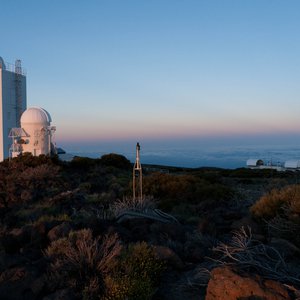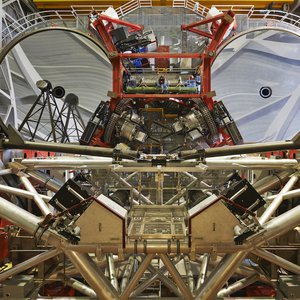Locations
The research activities of the AIP are geographically spread over different locations in and around Potsdam, in the US and on Tenerife, while all personnel are located in Potsdam. The Potsdam-Babelsberg Research Campus constitutes the institute's main location, which accommodates about 200 employees.
You can visit our locations virtually: https://vr.aip.de/aipvr.html

Domes on the Babelsberg research campus.
Credit: AIPResearch campus Potsdam-Babelsberg
The campus area, which Kaiser Wilhelm II once gifted to astronomers for the purpose of constructing an observatory, is located on the Babelsberg hill and directly connects to the Babelsberg Park. The whole historical ensemble of the Babelsberg Observatory forms part of the UNESCO world heritage site. In 1913, today’s Humboldthaus became successor to the Berlin Observatory, which had moved away from the ever growing metropolis to its current location under the then undisturbed Babelsberg night sky. Its originally preserved lenticular telescope provides an authentic impression of the working conditions in astronomy at the beginning of the 20th century. The building now serves as a workplace for scientists from the Cosmic Magnetic Fields section.
Next to the Humboldthaus are the meridian houses. There, the passages of stars were once measured for an exact determination of time and position. Today, they host AIP’s media and communication centre, where robotic telescopes on Tenerife are remotely controlled and data streams converge. The former director’s villa and porter’s lodge now accommodate the administrative staff. Today’s library building, built in 1913, is also part of the historical area of the research campus.
The modern buildings Schwarzschildhaus and Leibnizhaus host the Extragalactic Astrophysics research area, the executive board, the technical section, project management, IT services, and the innoFSPEC team. High-performance computers, workshops, and two integration halls are also situated here.
Hence, the Babelsberg campus is more than a place where 20th century science history was made: it is also where people from all over the world use cutting-edge research infrastructure to explore the greatest possible dimensions as well as the origin, makeup, and fate of the universe as a whole.

Einstein Tower and Great Refractor on the Telegrafenberg in Potsdam.
Credit: dronearchive.orgThe Potsdam-Telegrafenberg Historical Site
On the Telegrafenberg, a 96-metre-high elevation in Potsdam, the “Science Park Albert Einstein“ hosts a conglomerate of major scientific institutions. The original site was designed as a science park in the style of an English landscape garden. Today, in addition to the AIP with its solar observatory Einstein Tower and the Great Refractor, the Helmholtz Centre Potsdam - GFZ German Research Centre for Geosciences, the Potsdam Institute for Climate Impact Research (PIK) and a branch of the Alfred Wegener Institute (AWI, a Helmholtz centre for polar and marine research) are located on the site. The first research institute built at the science park was the Astrophysical Observatory Potsdam (AOP), along with the Berlin observatory one of the predecessor institutions of the AIP. It was the first astronomical institute worldwide that had the term “astrophysics” in its name and research programme.
The initial buildings on the Telegrafenberg were constructed between 1874 and 1899. The main building of the AOP (today called “Michelson House”) was the first to be completed in 1876, the Great Refractor was finished in 1899. Personages such as Karl Schwarzschild, director of the AOP since 1909, and Albert Abraham Michelson, who performed a precursor of the famous Michelson-Morley experiment in the basement of the Michelson House, worked and conducted research at the Telegrafenberg over the years. In 1924, the completion of the Einstein Tower started the era of modern solar research in Potsdam and Germany. After almost a century in use, the Einstein Tower remains the largest solar telescope in Germany and solar physics remains a research focus of the AIP.
The name Telegrafenberg originates from an optical telegraph station (a six-metre-high antenna), which was installed in 1832 by order of Friedrich Wilhelm III. It formed part of the Prussian semaphore system, encompassing 62 stations between Berlin and Koblenz. The line was shut down in 1852 due to the adoption of electrical telegraphy. Today, a replica marks the telegraph line.
Among the historical sites at the Telegrafenberg, especially the buildings of the AIP, namely the solar observatory Einstein Tower and the Great Refractor, attract the public due to their unique historical tradition and architecture.
Telescopes
LOFAR
AIP contributes to the International LOFAR Telescope (ILT) with its own LOFAR (LOw Frequency ARray) station in Potsdam Bornim. LOFAR is a radio interferometer that observes in the frequency range 10 - 250 MHz. It was originally designed by ASTRON in the Netherlands and consists of 24 core stations near Exloo, 14 other remote stations across the Netherlands, and 13 international stations in countries across Europe, from Ireland to Poland, Sweden to France. The longest baseline in East-West direction is 1,885 km, in NorthSouth direction it is 1,301 km. Another station is presently being constructed in Irbene, Latvia.
Large Binocular Telescope (LBT) in Arizona
The LBT is located at an altitude of 3,200 metres on Mount Graham in Arizona. With its two 8.4-metre mirrors, it is currently the largest optical telescope in the world. It has the light-gathering capacity of a single 11.8-metre telescope and, when combined interferometrically, provides a spatial resolution in the sky corresponding to a single 22.8-metre giant. The telescope is in routine operation since 2018.
AIP participated in the LBT by developing and building the “Acquisition Guiding and Wavefront Sensing” units, which analyse light entering the telescope and provide signals for controlling the telescope and optimising the shape of the two primary mirrors. PEPSI is a high-resolution spectrograph and polarimeter built as a scientific instrument. It provides spectra of the highest quality and is available to the entire German and LBT partner community. A small solar telescope and a 450-metre-long fibre link with the 1.8-metre Vatican telescope can also be used in conjunction with PEPSI. Corresponding to the expertise at AIP, the solar telescope and its daytime operation are fully automated.
STELLA and GREGOR at Tenerife
STELLA, short for STELLar Activity, consists of two fully robotic, 1.2-metre telescopes at Observatorio del Teide located in Tenerife, Spain. They uniquely combine a high-resolution spectrograph, SES, and a wide-field imager, WiFSIP. STELLA is a long-term project for observing and monitoring activity tracers on cool stars with two robotic telescopes. It was inaugurated in 2006 and has been in fully robotic operation ever since. It dwarfs commonly operated telescopes not only in running costs: Over the years, the STELLA team was successful in lowering the technical downtime of the telescopes to a mere 2%.
The Canary Islands of Tenerife and La Palma rank among the best sites for high-resolution solar observations. The locations are characterised by many hours of sunshine and stable atmospheric conditions, which are a prerequisite for studying the minute details of the active and dynamic Sun. The 0.7-metre Vacuum Tower Telescope and 1.5-metre GREGOR solar telescope at Observatorio del Teide form the core research infrastructure for ground-based solar physics in Germany. A consortium led by the Leibniz Institute for Solar Physics (KIS) in Freiburg with the Max Planck Institute for Solar System Research (MPS) in Göttingen and AIP as partners operates these telescopes and their dedicated suite of post-focus instruments. Novel instrument concepts and data analysis techniques are developed in collaboration with the Instituto de Astrofísica de Canarias (IAC). These will pave the way for next-generation telescopes such as the 4-metre European Solar Telescope. Typically, imaging and spectropolarimetric data are gathered on 250 observing days during the observing season from April to December.

LOFAR-Station in Potsdam-Bornim.
Credit: AIP
Sunset at the Teide Observatory with STELLA (right) and GREGOR (left).
Credit: AIP/M. Weber
Top-down view of the two 8.4-metre LBT mirrors and the instrument platform between them.
Credit: LBTO